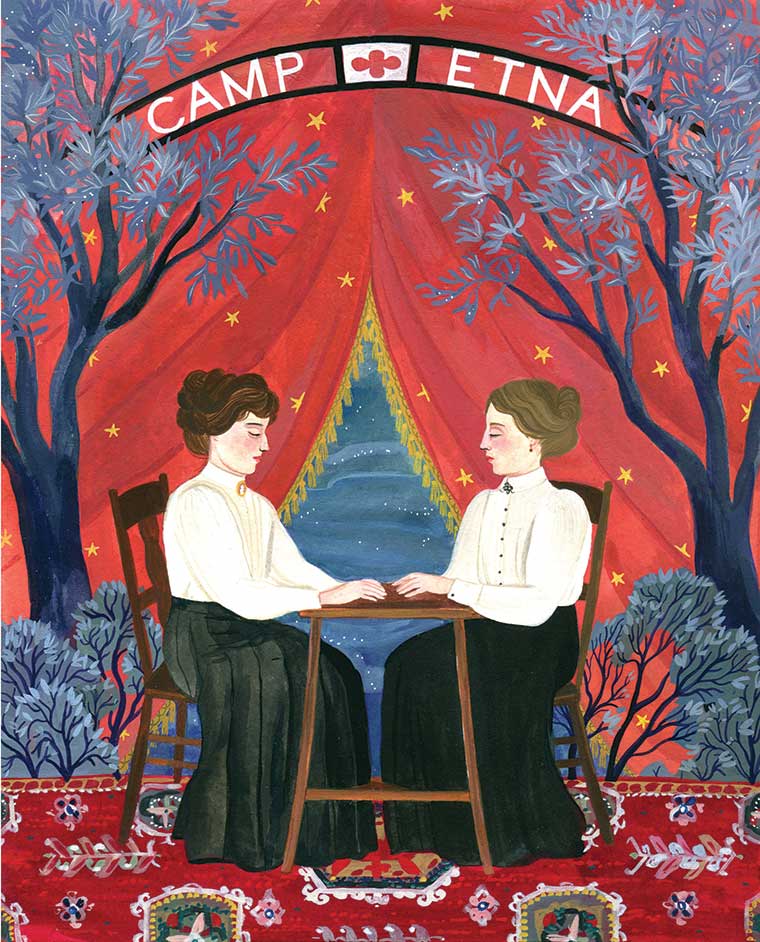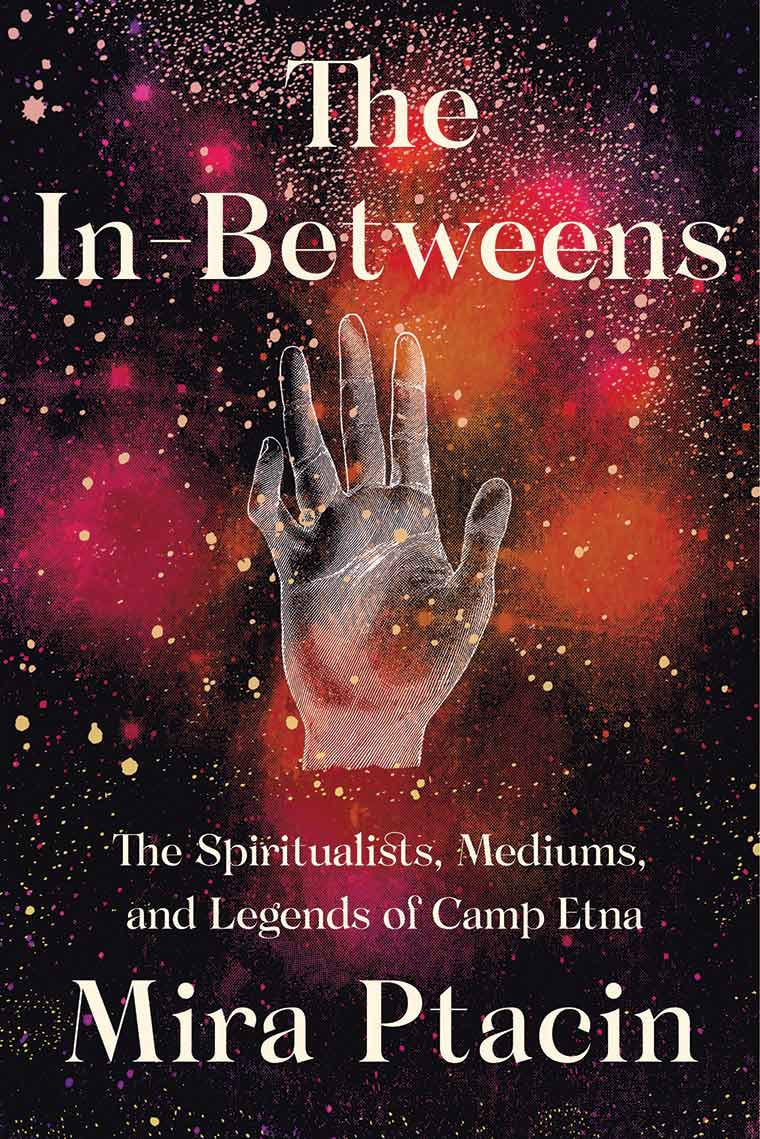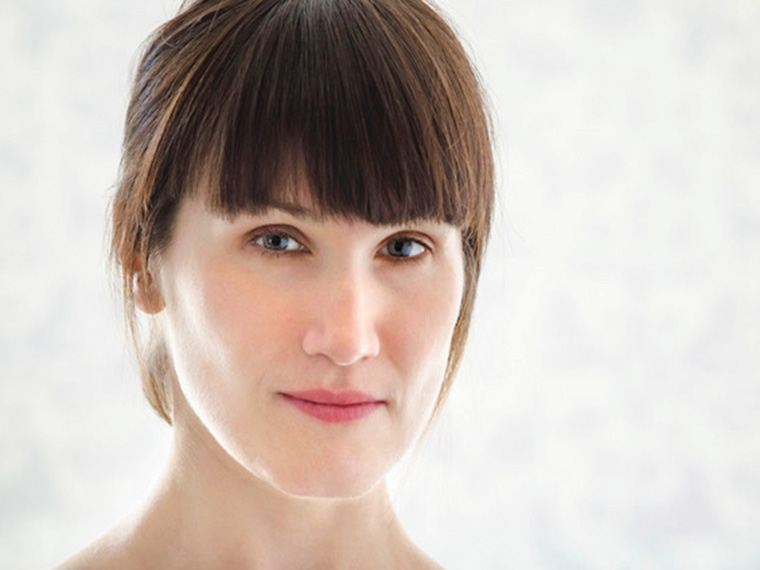Opening Season
With a creative writer’s open mind and a journalist’s keen curiosity, Mira Ptacin MFA ’09 explores the history and practices of a little-known Spiritualist community in the woods of Maine. Since its inception nearly a century and a half ago, Camp Etna has beckoned to believers devoted to bridging the divide between the mortal world and the world beyond.

They believed they would live forever. After our bodies were stiff and buried under rosebushes, we humans—in fact, all creatures—would awake as more advanced beings. In the afterlife, our souls would gain not only the ability but also the inclination to provide truths for the living, clues and insights into all their quandaries. Once we were dead, we would finally understand life. This had always been possible and always would be. Those left breathing just had to listen.
Despite the eternity of it all, they set the date of March 31, 1848, as their beginning. A Friday. It began with a sound: a tapping. A coded conversation between two sisters and an unknown third party: a ghost in the wall. “Mr. Splitfoot” the two sisters had called him. The three of them talked. Folks witnessed—first parents, then neighbors. Word spread. Next came the chin-wags and the believers, the opportunists and the newspapermen. This led to more demonstrations, conversations—seances, if you will—that unearthed glimmers of hope. Faith.
The turbulent decade about to unfold—the railways unfurling across the continent, the glittering promise of gold in the West, the slow hurtle toward a war that would rend the country—made the timing just right; an ancient longing was released into the air and blown like a thousand seeds soon to take root in cities and towns large and small, known and not, across the country. It would grow into a cultural revolution that challenged, then changed the established American institutions of patriarchal authority and the Christian Church. It was the conception of a religion that by 1897 would spread across the United States and Europe, sprouting more than 8 million disciples. And at the dead center of all those believers were two sisters, Kate and Margaret.
In Hydesville, a small town in upstate New York, Kate and Margaret Fox, ages 12 and 15, lived in a house that had always felt sinister to the townsfolk, even before their family had moved to town.
One night, their parents started hearing things. First some small taps, then harder knocks that sounded like apples dropping off the dresser in the girls’ room. Soon, those noises grew more and more sophisticated, stronger, like the scrape of a bed foot being dragged across the plank floor. But when Kate and Margaret’s mother would rush upstairs and fling open the door to their room, her daughters would both be asleep. Finally, after much confusion and questioning, the sisters called their mother into the room.
Mother, watch.
Margaret, the elder, snapped her fingers once—tik—and was immediately answered by a tap in response. She snapped twice, and something snapped twice. Little Kate’s hands were in her lap, unwavering. There was something in that room. …
Two days later, the evening before April Fools’ Day, it happened again. Picture young Kate and Margaret in long, pearl-colored nightgowns and bouncy hair, dangling their feet from the edge of their unmade bed, this time surrounded by their parents, huddling neighbors, and flickering candlelight. Soon enough, the spirit spoke, communicating in the coded language the girls and the ghost had already established: One tap meant yes. Two taps, no.
The next morning, neighbors left the Fox girls’ bedroom believing they’d spent a night with an apparition and two girls with mystical powers. …
The story might have ended then, or maybe after the sisters were sent to Rochester by their parents to protect them from a potential witch-hunt. There, the girls could live under the eye of their older and more responsible sister, Leah, and move on from what they’d started and live a normal life. But the ghost—Mr. Splitfoot—seemed to follow them, and Leah turned out to be more opportunistic than she was reliable, a better publicist than guardian. Leah booked her younger sisters as the headliners in a 400-seat theatre in New York, where the sisters took questions for the dead from the audience. Thus marks 1849 as the first public demonstration of Spiritualism, in Corinthian Hall, Rochester. Kate and Margaret Fox emerged as mediums.
Within a few years, the girls became the talk of antebellum New York and were drafted to serve as clairvoyants for rich believers. On the corner of Broadway and Maiden Lane, the Fox sisters booked a suite and began showcasing their work in a parlor at Barnum’s, a swanky hotel owned by a cousin of the famed showman and huckster, P. T. Preeminent New Yorkers frequented the scene, mostly inquiring about “the state of railway stocks or the issue of love affairs,” which soon brought forth the attention of other notables and luminaries to Spiritualism: Elizabeth Cady Stanton, Frederick Douglass, William Cullen Bryant, George Bancroft, Sojourner Truth, James Fenimore Cooper, Nathaniel Parker Willis. …
Some believed. But for many, the sisters were a diversion, a curiosity of the times: there were no televisions, no movies or recorded music. Entertainment wasn’t as ubiquitous as it eventually became; these female mystics were the reality show. The young women were captivating—even if their audiences didn’t believe in ghosts or spirit communication, this was the first time they’d ever witnessed a female—let alone two—speak in public, on a stage, not just with permission but by popular demand. At the time, a woman speaking in public was essentially unheard-of. And on top of that, these girls were offering not only hope but proof: there was life after death. …
Women’s-rights advocates quickly and fully joined forces with the Fox sisters, backing them and building the bridge that linked Spiritualists to the suffragettes, thus adding a strong foundational element of feminism to the Spiritualist movement at its outset.
Because they were young women, the Fox sisters also delivered an additional kind of radicalism. Kate and Maggie’s exhibition struck at something vital in a certain kind of seeker. For those who felt shackled by the mores of the times, the very beings of the teenage sisters were revolutionary. While seeking a higher power was nothing new, the Fox sisters’ message rode on the American yearning to go it alone, to live one’s life in accordance to self-guidance and one’s individual intuition without needing someone’s permission, without hierarchy, without interference of the Church or any other institution. The Fox sisters represented something that had been feared by many, yearned for by others, and only imagined by the patriarchal American society at the time: a woman’s right to self-sovereignty. Each time the Fox sisters addressed a crowd, they were also shedding their Victorian sensibilities and their assigned gender roles, breaking the ossified boundaries between classes, ages, sexes. Each time they stepped onto the stage, they were inspiring a silent but large segment of the nation that was hungry for change and for someone to start it. Unlike their Christian contemporaries, the Fox sisters proved that Americans no longer had to rely on speculation or even revelation for information about the ultimate fate of the soul; we would continue to evolve after death, even if we weren’t baptized. You didn’t need a deacon, priest, bishop, pope, or any man, for that matter, to connect you to the higher power; Spiritualism eliminated the need for a savior. As they continued to dazzle the crowds, the sisters planted the seed of new religion—what would soon be named Spiritualism with a capital S—kindling the individual’s request for individual truth and permission to believe in it with a fearless tenacity.
Around the same time, another group of radical American reformers was gaining momentum. Just down the road from where the Fox sisters first publicly demonstrated their seances with Mr. Splitfoot, the very first women’s-rights convention was held in Seneca Falls, New York, in July of 1848. Many of those who attended the Seneca Falls Convention had already caught wind of the two sisters, and these feminists lent their support to the young women and their cause. These girls were not powerless, mute observers, and this convinced the feminists of their authenticity. They praised the girls for their bravery and progressiveness, for defying their roles as politically, financially, sexually, and socially repressed second-class citizens. Women’s-rights advocates quickly and fully joined forces with the Fox sisters, backing them and building the bridge that linked Spiritualists to the suffragettes, thus adding a strong foundational element of feminism to the Spiritualist movement at its outset, with both movements calling for the “emancipation of women from all legal and social disabilities.” …
The collaboration wasn’t just limited to protofeminists. In fact, before the support from women’s-rights advocates, it was a small group of abolitionists who first took the Fox sisters seriously. Upon the initial boost from big sister Leah Fox, and before Kate and Maggie hit their stride, it was a group of abolitionist Quakers who helped establish and endorse the girls’ first public seances for smaller crowds. The merging of the sisters and the Quakers was quite natural: Quakers believe in self-sovereignty, that no human should rule over another; they don’t have much use for religious authority. They believed that when a white person controlled the life of a person with darker skin, or when a husband exerted authority over his wife, he was usurping the place of God. The Quakers soon realized that this new practice of Spiritualism eliminated the place of a male authority and replaced it with new and more “feminine” qualities. That is to say: harmony replacing forcefulness, acceptance replacing domination, individualism replacing hierarchy. Radical individualism. The women’s-rights movement, the abolitionists, and the Fox sisters, all guided by their common credo, merged like railroad cars hitched to a locomotive belief that each human being has the capacity to do good and to right the world’s wrongs, in whatever shape, form, or plane they may appear. …
By the 1850s, Spiritualism had spread across the nation, with women front and center of the anti-official, anti-figurehead, anti-organization organization. Citizens were holding seances and gathering to talk to spirits as casually as we gather for Sunday brunches. By then, Spiritualism wasn’t just limited to audience members or activist leaders anymore. … It’s impossible to know how many times during this era the seance ritual was performed—Spiritualists hardly kept any courtly authoritative documentation. But the movement grew, and as it did, Spiritualism found more and more ways of disseminating information, organizing, and keeping believers united. … All the while, skeptics and critics of Spiritualism said the movement, which they nicknamed “Rapplemania,” was just a passing trend. They couldn’t have been more wrong.
Spiritualism promised that if you died before you were baptized, you would not suffer in the eternal flames of hell. Spiritualism offered not only the hope of life after death in a heavenly realm; it offered proof of immortality through conversations with dead loved ones.
Then came 1861 and the Civil War, a nationwide tsunami of grief taking out at least 620,000 souls, nearly all at once. Never before had so many Americans at the same time been hit with such death and sorrow and mortality. Surprisingly, most antebellum Americans did not belong to a church, and only about 25 percent belonged to a Christian denomination. Mourners needed an outlet and they needed hope, something different from the you’re-born-a-sinner, fire-and-brimstone afterlife they’d been told to fear and respect. Spiritualism offered the perfect balm. It rejected traditional Christianity. It demanded less and promised more. Spiritualism promised that if you died before you were baptized, you would not suffer in the eternal flames of hell. Spiritualism offered not only the hope of life after death in a heavenly realm; it offered proof of immortality through conversations with dead loved ones. …
Prominent men got on board as well. … Consider Pierre Curie, Nobel laureate, French physicist, and husband of Marie Curie. Consider Sir Arthur Conan Doyle, known for penning The Adventures of Sherlock Holmes, who went on to write the mammoth multivolume work The History of Spiritualism and create the “Ghost Club” (which was frequented by Charles Dickens). Consider Dr. Alfred Russel Wallace, co-discoverer of the theory of evolution with Charles Darwin, who, after much research, concluded and declared widely that spirit phenomena could be proven scientifically. Or consider the well-respected but little-known East Coast farmer and preacher Daniel Buswell, who, in 1858, along with his wife, Lizzie Francis Mosley, at the top of the hill on the east line of Etna-Bangor Road in a Maine settlement called Crosbytown, hosted the very first of many Spiritualist gatherings on their land. These camp meetings would eventually bloom into one of the largest Spiritualist communities in the nation: Camp Etna.
Illustration by Becca Stadtlander
Author photo by Shane Thomas McMillan

Mira Ptacin is the author of Poor Your Soul (Soho Press 2016), the acclaimed memoir named a Kirkus Reviews Best Book of the Year. Ptacin has written for NPR, Guernica, New York, Tin House, and VICE, among other publications. Freerange Nonfiction, the reading series and storytelling collective she founded in Manhattan, was selected by New York Magazine as a “Critic’s Pick” and was voted Best Nonfiction Reading Series by Electric Literature. Ptacin has served as a faculty member at Sarah Lawrence’s Summer Seminar for Writers and teaches memoir writing to women at the Maine Correctional Center. She lives with her family on Peaks Island, Maine.
